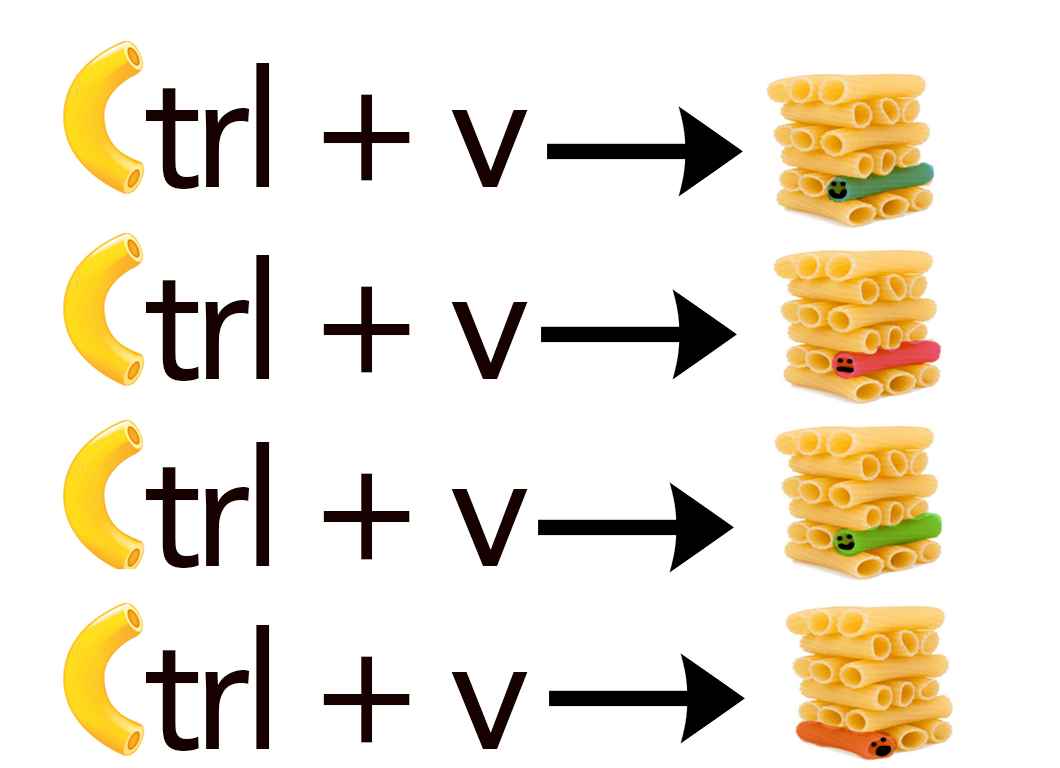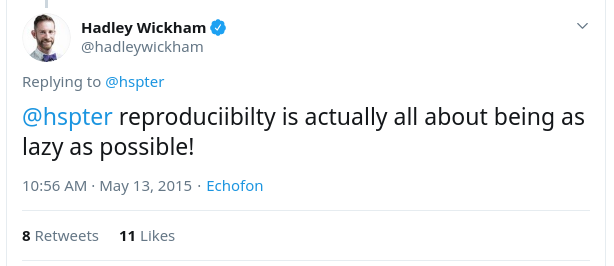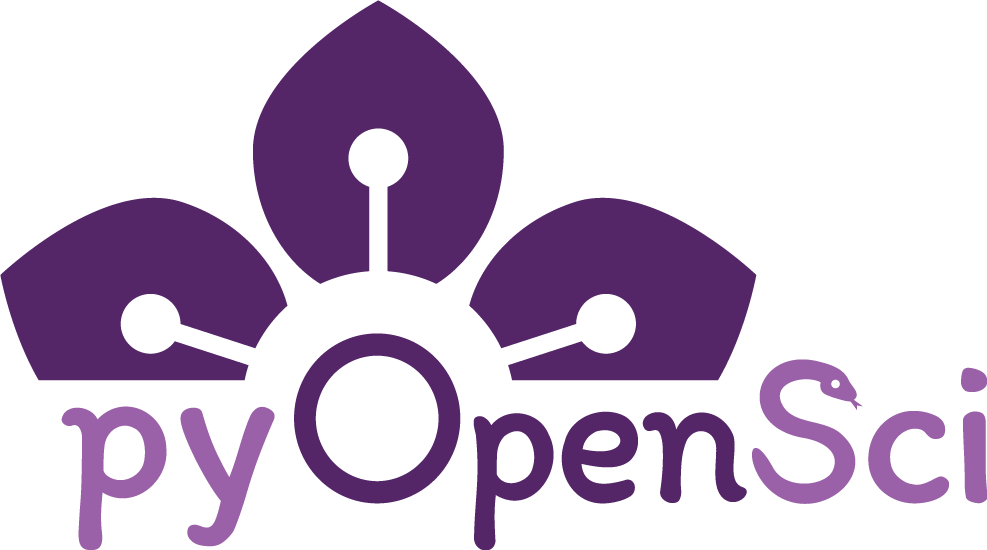Write DRY, modular Python code#
What you will learn
Define the DRY principle.
List key strategies for writing DRY code in Python.
Explain how these strategies help you write DRY code.
Don’t Repeat Yourself (DRY)#
The DRY approach to programming refers to writing functions and automating repeated sections of code. If you perform the same task multiple times in your code, consider a function or a loop to make your workflow more efficient.

Don’t repeat yourself: remove repetition in your code#
Why write efficient code#
DRY code relates to reproducible science because one component of reproducibility is writing code that is easy to read. If your code is easy to read, it will be easier for your future self to understand that code. It will also be easier for your colleagues to work with and contribute to your code. This is important, but there is an even more selfish reason to consider writing efficient code.
Efficient coding will make your life easier, too.

Reproducibility can mean being as lazy as possible. When you can avoid repeating steps and code, you should do just that. Source: Twitter/X.#
Don’t Repeat Yourself: DRY#
DRY (Don’t Repeat Yourself) is a principle of software development. The focus of DRY is to avoid the repetition of information.
Why?
One main reason is that when you write code that performs the same tasks repeatedly, any modification of one task requires the same change to be made to every place that you use that task! Editing every instance of a task is a lot of work.
By implementing DRY code approaches, you can make your code:
easier to follow and read (for yourself as well as others), thereby supporting reproducibility
easier to update because you only have to update your code once, rather than everywhere that code block is used
Strategies for writing DRY code#
Below you will learn about three commonly used strategies associated with writing clean code:
Write a function when a task is repeated over and over.
Create loops that iterate over repetitive tasks.
Use conditional statements to control the flow of if and when code is executed.
The above three approaches are often used together when writing code.
Write functions to document and simplify repeated tasks#
A function is a reusable block of code that performs a specific task. Functions have inputs and outputs. Functions can help you to both eliminate repetition and improve efficiency in your code through modularity. If you have been using Python for any period of time, you have already used built-in Python functions.
For example, print() is a function used to write output to the Python console (or a Jupyter Notebook). If you have used Pandas, pd.read_csv() is a function that reads a text file into Python in a dataframe format. The print() and read_csv() functions are useful to you as a Python programmer because you do not need to know the specific lines of code that are required to print(). All that you need to know is how to call the print command: print("My text here").
Below, you have a custom function with a custom name.
def convert_to_kelvin(temperature_fahr):
"""Convert temperature in Fahrenheit to kelvin.
Parameters:
-----------
temperature_fahr: int or float
The temperature in Fahrenheit.
Returns:
-----------
The temperature in kelvin.
"""
return ((temperature_fahr - 32) * (5 / 9)) + 273.15
This function converts temperature in Fahrenheit to kelvin. You can learn more about it by reading its documentation (docstring).
Now, imagine that you need to perform this calculation over and over.
temp = 55
new_temp = ((temp - 32) * (5 / 9)) + 273.15
temp2 = 46
new_temp_k = ((temp2 - 32) * (5 / 9)) + 273.15
In the example above, you are repeating the same calculation twice.
In this example:
if the calculation needs to change, you need to change it twice
it’s not necessarily clear what the calculation is doing unless you know the calculation itself.
The example below is cleaner because now you are replacing a repeated calculation with a function. If this function is well-defined with a docstring that describes what it does, it is easier to both understand and use. If you need to change the calculation itself, you can do so once in the function. Then, you rerun your code.
temp = 55
new_temp = convert_to_kelvin(temp)
temp2 = 46
new_temp_k = convert_to_kelvin(temp2)
The task above could be further simplified using loops which will be discussed below. Writing modular code allows you to subdivide tasks of a workflows into organized units of code that can be reused by yourself and others, often without them needing to know the specific details of the code.
Write loops in Python To simplify iterative repetitive tasks#
A loop executes a sequence of operations repeatedly in a specified order.
Loops can help you eliminate repetition in code by replacing duplicate lines of code with an iteration. This means that you can iteratively execute the same code line or block until it reaches a specified endpoint.
For example, consider the following lines of code:
print(avg_monthly_precip)
print(months)
print(precip_2002_2013)
This code could be replaced by a loop that iterates over a list of variable names and executes the print() function until it reaches the end of the list:
variables = [avg_monthly_precip, months, precip_2002_2013]
for variable in variables:
print(variable)
You can create lists of variables, filenames, or other objects like data structures upon which you want to execute the same code. These lists can then be used as variables in loops.
Conditional Statements#
A conditional statement is used to determine whether a certain condition exists before code is executed. Conditional Statements can improve the efficiency of your code by providing you with the ability to control the flow of your code, such as when or how code is executed.
For example, conditional statements can be used to check that a certain variable or file exists before code is executed, or to continue code if some criteria is met such as a calculation resulting in a specific value.
In the example below, you can combine a loop and a conditional statement to only print the variable value if the value is greater than 20.
avg_monthly_precip=100
months=20
precip_2002_2013=30
variables = [avg_monthly_precip, months, precip_2002_2013]
# This list comprehension loops over each variable and prints the value if it is greater than 20
[print(variable) for variable in variables if variable> 20]
Practice Applying PEP 8 To Your Code#
Take a look at the code below.
Create a list of all of the things that could be improved to make the code easier to read / work with.
Identify changes to specific items that would help the code adhere to the PEP 8 style guide.
Additional Resources#
# Create variable
variable=3*6
meanvariable = variable
#calculate something important
mean_variable = meanvariable * 5
# last step of the workflow
finalthingthatineedtocalculate = mean_variable + 5

